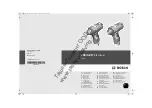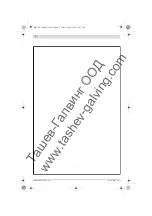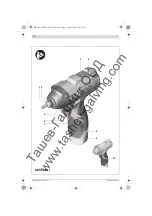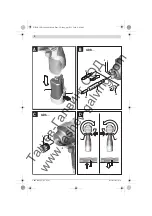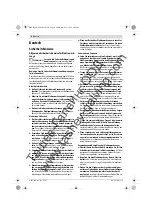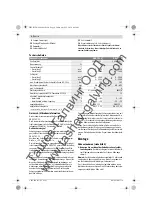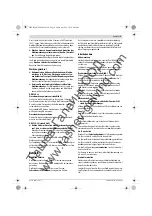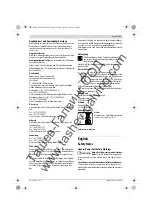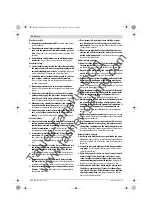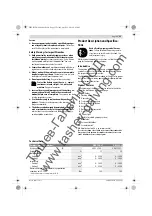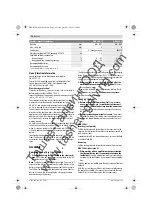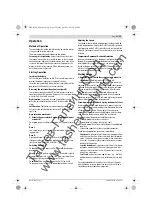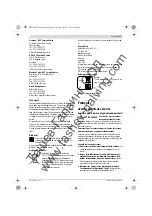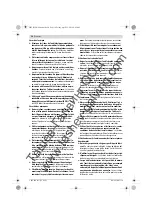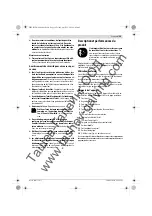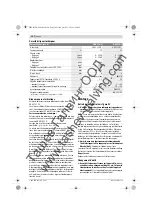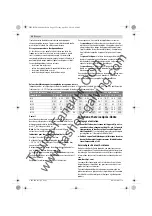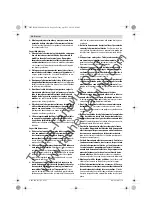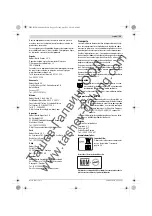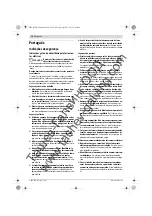
English |
15
Bosch Power Tools
1 609 92A 2SL | (22.4.16)
Operation
Method of Operation
The tool holder
1
with the tool is driven by an electric motor
via a gear and impact mechanism.
The working procedure is divided into two phases:
Screwing in
and
tightening
(impact mechanism in action).
The impact mechanism is activated as soon as the screwed
connection runs tight and thus load is put on the motor. In this
instance, the impact mechanism converts the power of the
motor to steady rotary impacts. When loosening screws or
nuts, the process is reversed.
Starting Operation
Inserting the battery
Set the rotational direction switch
7
to the centre position to
protect the power tool against accidental starting.
Insert the charged battery
6
from the front into the base of the
power tool until the battery is securely locked.
Reversing the rotational direction (see figure D)
The rotational direction switch
7
is used to reverse the rota-
tional direction of the machine. However, this is not possible
with the On/Off switch
8
actuated.
Right rotation:
For driving in screws and tightening nuts,
press the rotational direction switch
7
through to the left
stop.
Left Rotation:
For loosening and unscrewing screws and
nuts, press the rotational direction switch
7
through to the
right stop.
Gear selection, mechanical
Actuate the gear selector 3 only when the machine is at
a standstill.
Two speed ranges can be preselected with the gear selector
3
.
Gear I:
Low speed range; for screwdriving or working with large drill-
ing diameter.
Gear II:
High speed range; for working with small drilling diameter.
If the gear selector
3
cannot be pushed through to the stop,
lightly turn the drill chuck with drill bit.
Switching On and Off
To
start
the machine, press the On/Off switch
8
and keep it
pressed.
The power light
9
lights up when the On/Off switch
8
is slightly
or completely pressed, and allows the work area to be illumi-
nated when lighting conditions are insufficient.
To
switch off
the machine, release the On/Off switch
8
.
To save energy, only switch the power tool on when using it.
Adjusting the Speed
The speed of the switched-on power tool can be variably ad-
justed, depending on how far the On/Off switch
8
is pressed.
Light pressure on the On/Off switch
8
results in a low rotation-
al speed. Further pressure on the switch results in an increase
in speed.
Temperature Dependent Overload Protection
In normal conditions of use, the power tool cannot be over-
loaded. If the power tool is overloaded or not kept within the
permitted battery temperature range, the power output is re-
duced or the power tool is switched off. The power tool will
not run at full power output again until the permitted battery
temperature has been reached.
Working Advice
Apply the power tool to the screw/nut only when it is
switched off.
Rotating tool inserts can slip off.
The torque depends on the impact duration. The maximum
achieved torque results from the sum of all individual torques
achieved through impact. The maximum torque is achieved
after an impact duration of 6–10 seconds. After this dura-
tion, the tightening torque is increased only minimally.
The impact duration is to be determined for each required
tightening torque. The actually achieved tightening torque is
always to be checked with a torque wrench.
Screw Applications with Hard, Spring-loaded or Soft Seat
A test in which the achieved torques in an impact series are
measured and transferred to a diagram will produce the curve
of a torque characteristic. The height of the curve corre-
sponds with the maximum reachable torque, and the steep-
ness indicates the duration in which this is achieved.
A torque gradient depends on the following factors:
– Strength properties of the screws/nuts
– Type of backing (washer, disc spring, seal)
– Strength properties of the material being screwed/bolted
together
– Lubrication conditions at the screw/bolt connection
The following application cases result accordingly:
– A
hard seat
is given for metal-to-metal screw applications
with the use of washers. After a relatively short impact du-
ration, the maximum torque is reached (steep characteris-
tic curve). Unnecessary long impact duration only causes
damage to the machine.
– A
spring-loaded seat
is given for metal-to-metal screw ap-
plications, however with the use of spring washers, disc
springs, studs or screws/nuts with conical seat as well as
when using extensions.
– A
soft seat
is given for screw applications, e. g., metal on
wood or when using lead washers or fibre washers as back-
ing.
For a spring-loaded seat as well as for a soft seat, the maxi-
mum tightening torque is lower than for a hard seat. Also, a
clearly longer impact duration is required.
OBJ_BUCH-2846-001.book Page 15 Friday, April 22, 2016 8:42 AM
Та
ше
в
-
Га
лв
ин
г
ОО
Д
www.tashev-galving.com

